Excitement for purchasing our homestead almost left us on the wrong piece of land. With some money in the bank, we were READY to have land and start our own homestead. We fell in love with a cozy little yurt property on 5 acres with a seasonal stream.
Long story short, the owner jerked us around and ultimately we did not end up there. Otherwise, we would have happily of bought his land, and very soon after, would have figured out that we did not have enough land for our homestead desires.
We should have spent more time asking ourselves questions about what exactly we wanted to do on our land and how much space we would need for it.
Knowing the answer to these questions early on in your search can help narrow what you are looking for and get clear about your homestead goals. Depending on what size lot you’re looking at will determine how far you need to move away from a city, how easy it is to find what you’re looking for and what you’ll ultimately be able to do on your land.
However, it’s a complex question and there is no exact or right answer!
That said, knowing what elements are “must have” or “like to have” can help get you in the ballpark and prevent your from buying 2 acres when you really need 10 acres.
Getting Clear
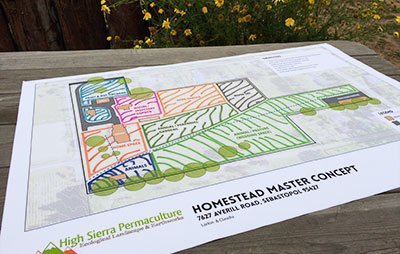 The first thing you need to do is define what you think you want to do on your homestead.
The first thing you need to do is define what you think you want to do on your homestead.
This will tell you what elements (e.g. garden, chickens, goats etc) you need to have room for on the land.
If you’re not sure, this is a perfect time to make a homestead plan for what you desire into categories like: must have, maybes or unsure. From there, you can break down each element and research. A great way to get to know any of these particular elements would be to check out some farms, help with livestock or construction projects.
Think about how many structures, how many people, types of animals, garden, greenhouse etc… that you might ultimately want/need and pull together a complete list.
This picture is now the foundation and will help you find out how many acres you might need.
How Much Land Do You Need?
There are a lot of variables that dictate how much land you will need, based on everything you wish to have.
Example Chickens (of course)
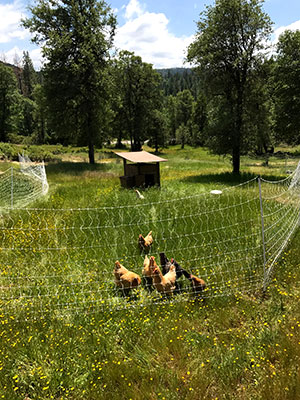 To better illustrate, let’s work with a common homestead animal: chickens.
To better illustrate, let’s work with a common homestead animal: chickens.
Let’s say you want to keep a flock of 8 laying hens for your family’s eggs.
The most basic setup would be an entirely enclosed coop and run (aka sacrifice zone). This might only take up a 200 square feet – quite small.
For some, this might be the ONLY option to keep chickens. For example, you might only have 1/2 acre of land. Or you may have too many predators, causing you to loose your flock without a fully enclosed chicken run.
On the other end of the chicken keeping spectrum would be a modified free-range approach using a portable electric fence and portable coop.
A 160’ electric fence would enclose a space of about 2500 sq feet. Approximately every two weeks the fence and coop would be moved to fresh ground, not placing the chickens back on an old spot for at least a few months to let the plants regrow.
Do you see how if your ideal chicken scenario is to free-range, you need couple acres of flat-ish pasture? And do you see how our simple question of how much space do I need for an element, like chickens, can have a wide range of answers? We went from 250 sq feet to 1-2 acres.
Just like this chicken example, for every element you want on your land you need to determine the range of space it could take up, from little to most. Of course this will only be a guess to the best of your ability and may even change over time.
Self-Sufficiency Requires More Space
Generally speaking, the more sustainably and holistically you want to do things on your homestead, the more space you will require.
The chickens are a perfect example again – feeding them naturally requires more space than feeding them processed feed.
Do you want to provide your own firewood for heating? Then you need to have enough trees that to burn each year without depleting your forest.
The more land you have the more resources you have. We do not buy compost because we are able to utilize our forest and harvest the incredible top soil provided by the oaks trees.
Want to graze your own large livestock for milk or meat? You guessed it, you’ll need a lot more acres to do this than chickens.
All this is not to say, you can’t have a very sustainable small homestead on just an acre or two, it just means there are some limitations that you can’t avoid on smaller properties.
And, to note: when I’m talking about self-sufficiency, I define it as growing and using as much from the land as possible, selling surpluses for cash to buy things we wouldn’t otherwise have.
As our friends over at PrimalSurvial speak to in their post about self-sufficiency, it’s not very realistic unless you’re willing to live like a caveman, but what you can do is define what it means to you and work toward those goals.
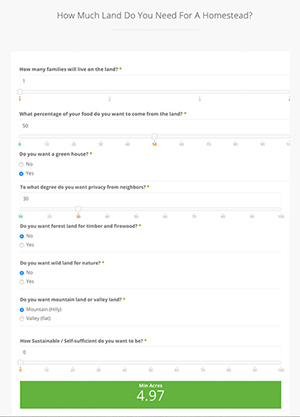
Land Size Calculator
Want a quick guess at how large of a homestead you will want?
I have made a tool to help you calculate how much land you will need.
Based upon the number of people living on the land, what elements, animals an other desires you have – it gives a rough estimation for the potential land size that would be most suitable.
Yes, I want to use the Calculator!Homestead Sizes
I can hear you saying, alright Bret, I get it. It take a bit of planning to figure out how much land I’ll need. But can you give some examples of what one might be able to do on different size farms or homesteads?
Glad you asked, yes I can answer this from the homesteads I have been over the years!
Here are some homestead acreage examples with permaculture and sustainability in mind:
Mini Homestead: 1.5 acres to 5
A client of mine has been working on an incredible mini homestead on just 1.5 acres!
They have an home, garage, orchard, garden, water harvesting earthworks, native garden and wild garden. Their master plan ultimately include chickens, rabbits, a couple pigs, bees and a tiny house in the next couple of years.
Even with all of this in the works, they still have a bit of room to spare, though things are packed tightly and space is at a premium.
While smaller properties are limited in some ways, such as not being able to keep large livestock (humanely), you can still do a lot.
Permaculture encourages people to “stack functions” which helps save space.
Stacking functions, briefly, is having something preform multiple functions. For example, your green house might serve as a winter run for your chickens if the weather is too cold in your area.
When it comes to building, planting, creating on the land, people always look forward and backward, left and right. But what about up and down? Permaculture also teaches that we can stack things vertically to save space.
A perfect example of this is the well-known Three Sisters Guild in the garden.
It’s a Native American guild of 3 plants: corn, peas and squashes. The tall corn acts as a trellis, giving support for the peas to grow, which in turn fix nitrogen in the soil, feeding the corn. The squash are low-growing vines that cover the ground, protesting the soil and reducing water loss to evaporation. A lot of food can be grown in one small garden bed using methods like this!
PROS:
– Under 5 acres is very easy to manage
– Lots this size can be closer to towns or cities, easier for job situations
– Potentially cheaper purchase price, land taxes and overall cost to maintain
– Still plenty of space to grow foodCONS:
– Not enough space to really keep anything more than chickens, that are not confined to a “sacrifice zone*“
– light on resources like trees for firewood, space for water harvesting
– smaller garden space requires careful planning and less opportunities for subsistence crops like wheat
– often close in proximity to neighbors
– may have more county limitations for what you’re able to do with the land
* Sacrifice Zone = area of land that is always dead, bare dirt, often seen in chicken runs or goat pens. This is not, in my opinion, a humane or health way to raise an animal. Chickens for example, are foraging animals that need a diet that is composed of protein (mostly bugs, some grains) and plant matter. Even organic, whole-grain chicken feed does not provide a truly healthy and balanced diet. So a healthy chicken, one that will give you the healthiest eggs and meat, will need as much area to forage from as possible. (This topic of course could a an entire article on it’s own – this note is just a short definition to what I consider a sacrifice zone and it’s limitations.)
Small Homestead: 6 -10 Acres
I have spent a lot of time on 5 acre homesteads and it is a great size for the majority of of people.
You have enough space to do the majority of things you might want to on a homestead. Many of the properties I have been on of this size include everything mentioned in the mini-homestead section and still have acres to spare.
Starting in this size range there can be multiple homes or trailers. Often these are used for rental income, storage or farm work traders.
PROS:
– Enough land to do what 80% of people want without the difficulty of lots of acreage to manageCONS:
– Limited in grazing ability
– Limited in lumber and firewood sourcing
Medium Homestead – 11 to 30 acres
This size feels like the sweet spot to me (maybe it’s a bit biased because we’re sitting on 30 acres currently), but overall it is great size if your goals include multiple dwellings, large gardens, using timber for lumber or firewood, buffer space from neighbors, etc.
It’s the minimum size I would suggest for someone who is really striving to life a self-sufficient, holistic lifestyle on the land.
Currently, we’re utilizing about a 8 of the 30 acres. In this space we have our home, a shop, greenhouse, pasture for chickens, about an acre for garden and orchard, a rice paddy, a small wheat field, water harvesting earthworks and spaces for relaxing and entertainment. The other 22 acres are mostly untouched, leaving room for expansion of another dwelling and using the tree resources for milling and firewood. We intend to leave much of that wild for wildlife, however it does still need maintenance to keep fire danger at minimum, which is no small task.
PROS:
– Enough space to expand for almost any homestead desire
– Lots of resources (rocks, trees, water etc)
– Lots of microclimates, varied topography and terrain
– Ability to keep larger livestock and start free-ranging
– Ability to keep wild lands in tact and set aside for nature
– Enough land to maintain privacy and serenity from neighbors
– Typically less restrictions on land useCONS:
– Often can be far out of town, meaning long commuting times to work, school or stores
– Higher taxes or initial land cost
– A lot of land to manage, can be costly to keep maintained
– Resale may be more difficult
Large Homestead: 75 to 200 acres
I am confining our definition of a large homestead here to 75-200 acres, mostly because most readers will not embark on homestead adventures this large. If you are, awesome. This amount of land is best suited for larger scale agricultural endeavors and ranging livestock.
PROS:
– With this amount of acreage you can do about anything you want. The sky is the limitCONS:
– Cost to maintain land is very high
– Higher property taxes
– Cost to acquire is high
– Less people want to buy larger parcels, resale might take longer than on a smaller parcel
Not All Land Is the Same
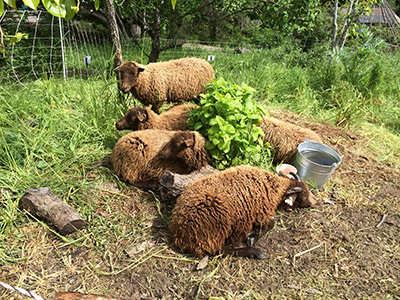
It will be important to consider that, especially in mountain areas, not all the land is usable typically due to steep slopes. So if you need 15 acres, you might need to buy 20 acres that has 15 usable acres and leave the 5 unusable acres to be wild lands.
Some areas of land are partially unusable in particular seasons. A meadow for example might be great pasture late spring through fall, but too wet to keep animals during the winter.
In some instances there are legal reason why an area of a parcel is unusable. Parameters like easements for utilities or protected water ways might mean you are limited in how you can use certain parts of a parcel.
The health of the area is also vital to look at. Land that is healthier will have a higher carrying capacity, land that is less healthy will have a low carrying capacity. Can you see bare dirt in the “pasture”? It’s not healthy and won’t support many animals grazing.
So, how much land do you need?
While I can not tell you for certain, this article should have given you a rough idea of what you should be looking for. Also, if you haven’t already, checkout the land size calculator as a next step in determining how much land you might need for your permaculture homestead or farm.
PS – TELL ME ABOUT IT IN THE COMMENTS BELOW!
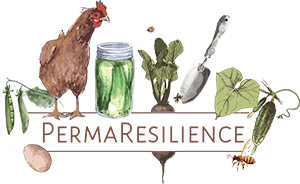


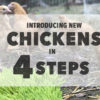
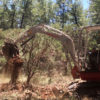

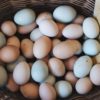


[…] the southern states, especially during the Reconstruction era, smaller homestead sizes were common as freed slaves and impoverished individuals sought to establish their own farms with […]
Awww.. The calculator page isn’t working. Gives a 404 error.
[…] do you want to do with the property now and in 10 years? How much land is needed to accomplish those […]
I’m Thinking About 7 to 15 acs To Do What I Am Wanting To Do In Our Small Homestead. We Plan To Have Chickens, Goats, A Few Pigs A Jackass, And A Few Cows..
[…] Quelle […]
Using the land calculator I got within .5 acre of what I actually bought!
Sweet! Of course the calc can’t take A LOT of things into account so interesting to find that it nearly nailed it for you.
[…] Read More […]